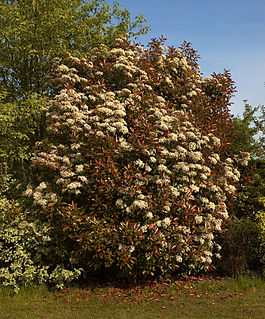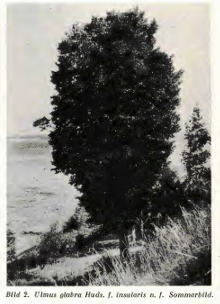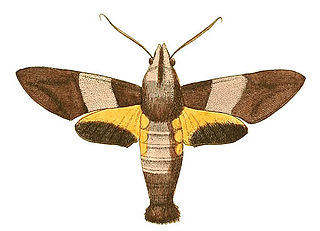
Ulmus glabra, the wych elm, Scotch elm or Scots elm, has the widest range of the European elm species, from Ireland eastwards to the Urals, and from the Arctic Circle south to the mountains of the Peloponnese in Greece; it is also found in Iran. A large, deciduous tree, it is essentially a montane species, growing at elevations of up to 1500 m, preferring sites with moist soils and high humidity. The tree can form pure forests in Scandinavia and occurs as far north as latitude 67°N at Beiarn in Norway. Wych elm has also been successfully introduced to Narsarsuaq, near the southern tip of Greenland (61°N).

Photinia is a genus of about 40–60 species of small trees and large shrubs, but the taxonomy has recently varied greatly, with the genera Heteromeles, Stranvaesia and Aronia sometimes included in Photinia.

Stranvaesia is a genus of flowering plants in the family Rosaceae. Its morphology is so similar to Photinia that it has sometimes been included within that genus, but recent molecular data indicate that the two genera are not related.

The grey dagger is a moth of the family Noctuidae.

Fine examples around the cathedral in 2007
The Wych Elm cultivar Ulmus glabra 'Fastigiata Stricta' was listed by Bean in Kew Hand-List Trees & Shrubs ed. 3. 273. 1925, but without description. It is possibly synonymous with U. glabra 'Fastigiata'.

The cultivar Ulmus glabra 'Insularis' [:'island'], the Ven island elm, a fastigiate form of Wych Elm from Sweden, was identified and described by Nilsson in Lustgården 30: 127. 1949, as U. glabraHuds. f. insularis. Nilsson considered it "closely related to subspecies montana(Stokes) Lindqvist". The cultivar arose from a tree on Ven island in Öresund sound, planted c.1900 between Haken and Husvik, possibly from self-sown local seedlings, and approaching 2 m in girth by the late 1940s.
The Wych elm cultivar Ulmus glabra 'Latifolia Aureo-Variegata' was first mentioned by Neubert in Deutsches Magazin für Garten- und Blumenkunde 1871 as Ulmus campestrisL.latifolia aureo-variegata.
The hybrid cultivar Ulmus × hollandica 'Etrusca' was first mentioned by Nicholson in Kew Hand-List Trees & Shrubs 2: 139. 1896, as U. montana var. etrusca, but without description. The tree at Kew, judged by Henry to be "not distinct enough to deserve a special name", was later identified as of hybrid origin, U. glabra × U. minor 'Plotii', by Melville.

Stranvaesia davidiana, the Chinese photinia, is a species of shrub grown as an ornamental plant. Its flowers are white and grow in close clusters, followed by small pome fruits. It originated from east Asia and has been introduced to North America as a garden plant. It is sometimes known as Photinia davidiana.

Photinia serratifolia, commonly called Taiwanese photinia or Chinese photinia is a flowering shrub or tree in the flowering plants family Rosaceae, found in mixed forests of China, Taiwan, Japan, the Philippines, Indonesia, and India.

Macroglossum passalus, the black-based hummingbird hawkmoth, is a moth of the family Sphingidae described by Dru Drury in 1773. It is known from Sri Lanka, India, Thailand, south-eastern China, Taiwan, southern Japan, Indonesia and the Philippines.

Caloptilia zachrysa is a moth of the family Gracillariidae. It is known from China, India, Japan, Korea, Sri Lanka and Taiwan.

Glabridin is a chemical compound that is found in the root extract of licorice. Glabridin is an isoflavane, a type of isoflavonoid. This product is part of a larger family of plant-derived molecules, the natural phenols.
Spilonota albicana, the white fruit moth, larger apple fruit moth or eye-spotted bud moth, is a species of moth of the family Tortricidae. It is found in China, Korea, Japan and Russia. It has been accidentally introduced in the Netherlands.

The putative hybrid elm cultivar Ulmus × hollandica 'Fastigiata' was listed and described as Ulmus glabra fastigiata in Graf von Schwerin's Mitteilungen der Deutschen Dendrologischen Gesellschaft (1915) by C. Berndt of the Berndt Nursery, Zirlau, Schweidnitz, who had received it in 1903 "from a renowned nursery in Holstein" as Ulmus montana fastigiata macrophylla, probably the Ulmus montana forma fastigiata macrophylla first mentioned by Dieck in 1885, without description. Berndt reported that U. glabra fastigiata was "easy to confuse with U. montana superba", a tree "known in the Magdeburg region as Ulmus praestans", which suggests that, like that cultivar, it may have been a form of U. × hollandica. An U. campestris glabra fastigiataArb. Musc. was distributed by the Hesse Nursery, Weener, Germany, in the 1930s.
The Wych Elm cultivar Ulmus glabra 'Grandidentata', listed as U. glabra var. grandidentata (Moss), may have been the tree first described by Dumortier in Florula Belgica, 25, 1827, as U. corylacea var. grandidentata, in cultivation before 1830. Green thought it a synonym of 'Cornuta'. 'Grandidentata' may be synonymous with U. glabra 'Corylifolia', which Green thought another synonym of 'Cornuta'.
The elm cultivar Ulmus 'Fastigiata Glabra' was distributed by the Späth nursery, Berlin, in the 1890s and early 1900s as U. montana fastigiata glabra. Späth used U. montana both for wych elm and for U. × hollandica hybrids like 'Dampieri', so the name does not necessarily imply a wych elm cultivar. A specimen in the Royal Botanic Garden Edinburgh was determined by Melville in 1958 as a hybrid of the U. × hollandica group. The cultivar did not appear in Späth's 1903 catalogue.
The elm cultivar Ulmus 'Glabra' was distributed by the Späth nursery, Berlin, in the 1890s and early 1900s as U. glabraMill.. Not to be confused with the species U. glabraHuds..

The Wych Elm cultivar Ulmus glabra 'Concavaefolia' is a curled-leaved form now rare in cultivation, and identified from old herbarium specimens labelled U. scabraMill. [:glabraHuds.] var. concavaefolia. It was also known as the wych 'Cucullata' cultivar.













